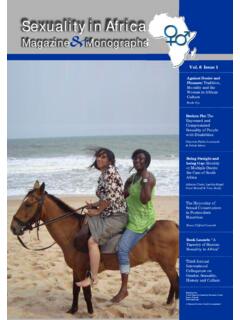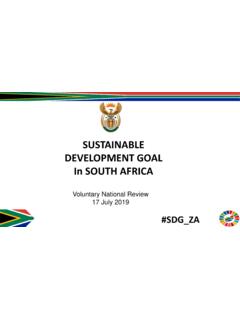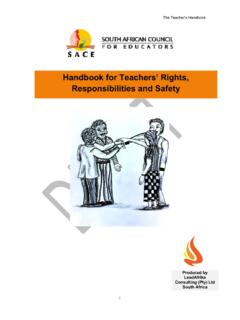Transcription of 2. IMMIGRATION POLICIES - United Nations
1 2. IMMIGRATION POLICIES . This chapter presents information about Governments' views and policy objectives to influence the level of IMMIGRATION in their countries. It also describes POLICIES that aim at influencing migration for permanent settlement, temporary labour migration, migration for family reunification and migration of highly skilled workers. IMMIGRATION POLICIES generally respond to labour market needs and demographic objectives of destination countries. Governments implement IMMIGRATION POLICIES through laws, regulations and programme measures with the objective to manage the volume, origin, direction and composition of migration flows.
2 In many countries, mostly in more developed regions, migration legislations have been characterized by regularization of flows and measures to better integrate immigrants in the host societies. In some cases, regional agreements have influenced the legislations of the countries involved. For example, European Union legislation influences the migration POLICIES of the 28 European Union countries, as well as of neighbouring countries in the European Union accession process. For instance, the so-called Blue Card is an EU-wide work permit implemented by a majority of European Union countries that establishes the conditions of entry and residence of third-country nationals for the purpose of highly qualified employment (European Union, 2009).
3 In recent years, many countries have adopted migration POLICIES as part of their national strategies and development plans. Examples include Bulgaria, Chile, the Czech Republic, Finland, Ireland, Lithuania, Mexico, Poland and Slovakia (OECD, 2011; 2012; 2013). Poland adopted its first migration strategy in 2012 that stressed the need for Poland to be more open to immigrants with needed skills and to facilitate their integration (OECD, 2013). Chile is developing a five-year migration policy with three strategic objectives: modernize the administrative process of residence applications, publish a new IMMIGRATION law, and address the status of asylum seekers as soon as they arrive in the country.
4 Governments in a growing number of destination countries have also incorporated human rights approaches in their migration POLICIES . For example, in 2011, Mexico redefined its migration policy by adopting the human rights approach to ensure and protect the human rights of all migrants. Emphasis was placed on family reunification issues, as well as access of migrants to health care and education, especially to minors. In most European countries, which host about one third of the global migrants stock, migrant status determines the accessibility to basic social protection and health care.
5 6 However, migration and border control have been increasingly integrated into security frameworks that emphasize policing , defence and 6. Spain is one of the few countries in Europe which extended welfare benefits (health, education, basic income for needy families) for all migrants regardless of their legal status in 2000. However, hit by financial crisis, the conservative Government passed an amendment law in 2012 restricting the health services for undocumented migrants below age 18, pregnant women and people in need of emergency care. Nevertheless, the regional governments of Andalusia, Basque Country, Catalonia and Navarre and medical associations refused to comply with the central Government based on the allegation of violation of human rights of the immigrants (Arango, 2013).
6 United Nations Department of Economic and Social Affairs Population Division 29. International Migration POLICIES : Government Views and Priorities criminality that could undermine the human rights-based approach ( United Nations News Centre, 2013).7. Rights of international migrants are protected under the 1990 United Nations International Convention on the Protection of the Rights of All Migrant Workers and Members of Their Families ( United Nations , General Assembly, 1990). 8 The unanimously adopted Declaration of the General Assembly's second High-level Dialogue on International Migration and development in October 2013 has called upon the Member States to reaffirm their commitment to the human rights of all migrants.
7 GOVERNMENT VIEWS AND POLICIES ON REGULAR IMMIGRATION . Among the 195 countries with data in 2011, 77 per cent of Governments considered the level of regular IMMIGRATION in their countries to be satisfactory. This perception has been stable over time, since the percentage of Governments satisfied has remained virtually unchanged since the mid-1990s. In 2011, 17 per cent of Governments viewed the level of IMMIGRATION in their countries as too high and 6 per cent viewed it as too low (table ). The percentage of Governments that were satisfied with the level of IMMIGRATION in their countries in 2011 was high in both more and less developed regions, and varied little by level of development .
8 Although the percentage of Governments that viewed the level of IMMIGRATION as too low has increased since the mid-1990s, only 6 out of 49 countries in more developed regions and only 6 out of 146 countries in less developed regions considered the level of IMMIGRATION to be too low in their countries in 2011. Policy objectives on IMMIGRATION levels appear to be largely in accordance with Governments' views. In 2011, about three quarters (73 per cent) of all Governments either had POLICIES to maintain the level of IMMIGRATION or they were not intervening to change it, while 16 per cent had POLICIES to lower it and 11 per cent had POLICIES to raise the level of IMMIGRATION (table and figure ).
9 Since the mid-1990s, the percentage of Governments with POLICIES to lower IMMIGRATION has declined (from 40 per cent in 1996 to 16 per cent in 2011), while the percentage to raise IMMIGRATION has increased (from just 4 per cent in 1996 to 11 per cent in 2011). 7. In May 2013, the United Nations Special Rapporteur on the Human Rights of Migrants urged the European Union to incorporate a human rights approach to IMMIGRATION , instead of solely focusing on security concerns ( United Nations News Centre, 2013). 8. Rights of migrant workers are also covered under several international conventions and recommendations adopted by the International Labour Organization.
10 Details about these conventions and recommendations are available at: :12030:0::NO::: (ILO, ). 30 United Nations Department of Economic and Social Affairs Population Division International Migration POLICIES : Government Views and Priorities Figure Government POLICIES to influence the level of IMMIGRATION , 1996 2011. 80. 72 73. 70. 60. 55. Percentage of countries 50. 40. 40. 30. 22. 20 16. 11. 10. 6. 4. 0. 1996 2005 2011 1996 2005 2011 1996 2005 2011. Raise Maintain/No intervention Lower Source: United Nations , World Population POLICIES Database. In 2011, two thirds of Governments in more developed regions and three quarters of Governments in less developed regions either had POLICIES to maintain the current level of IMMIGRATION or were not intervening to influence it (table ).















